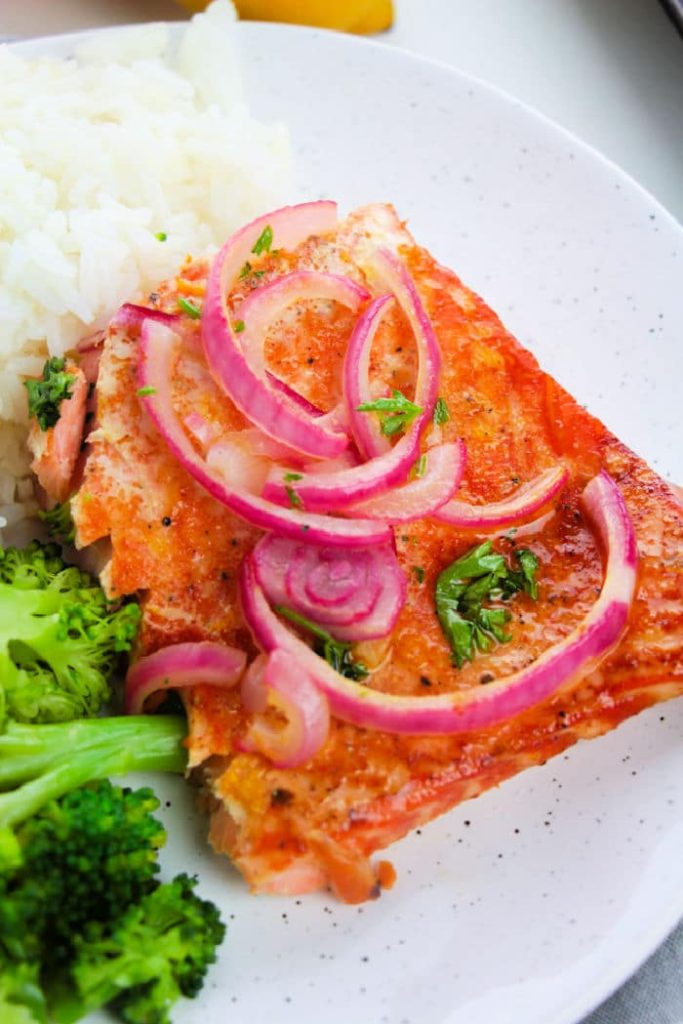How to Perfect Oven-Baked Salmon
Oven Baked Salmon, cherished for its delicate flavor and versatility, stands as a culinary favorite for many, offering a canvas for creative recipes and culinary mastery. Within this guide lies the blueprint to achieve culinary perfection every time you bake this beloved fish.
To master the art of baked salmon, precision is paramount. The secret lies in achieving a state of near completion within the oven, allowing the fish to reach its optimum texture and flavor during the resting phase.

Preparing salmon for baking is a straightforward affair. Begin with a generous tablespoon of olive oil, complemented by a dash of salt and pepper to enhance its natural flavors. Arrange the seasoned fillets on a baking sheet, ready to embark on their journey to culinary excellence.
According to culinary wisdom, baked salmon achieves its pinnacle of doneness when its internal temperature registers at 145 degrees Fahrenheit, measured at its thickest point. However, the path to this culinary nirvana involves a nuanced approach.
By adhering to a target temperature of 135 degrees Fahrenheit within the oven, followed by a brief interlude for the fish to ascend to the desired 145 degrees Fahrenheit outside the heat, you orchestrate a symphony of flavors and textures. This method ensures thorough cooking while safeguarding against the dreaded fate of dry, overcooked salmon.
The final revelation manifests as succulent, buttery flesh that delicately melts in the mouth, a testament to the harmonious fusion of culinary technique and reverence for the noble salmon.
You can also refer to our comprehensive guide on how to bake chicken wings at 400°F, ensuring they come out perfectly crispy and flavorful every time.
How long to bake salmon at 400
- Begin by preheating your oven to 400 degrees Fahrenheit, setting the stage for culinary excellence.
- Lay out a sheet of aluminum foil on a baking sheet, preparing a pristine canvas for your salmon masterpiece.
- With a gentle hand, anoint the salmon with the luscious richness of 1 tablespoon of either olive oil or avocado oil, infusing it with a kiss of flavor.
- Sprinkle a delicate veil of salt and pepper over the salmon, each grain a testament to the meticulous attention to detail in your culinary craft.
- Slide the adorned salmon into the preheated oven, where it shall undergo its transformation for approximately 15 minutes. However, keep a vigilant eye on the temperature, ensuring that the thickest part of the salmon reaches a blissful 135 degrees Fahrenheit, signaling its readiness.
- Once this temperature threshold is met, graciously remove the salmon from the oven, granting it a moment of repose. During this brief interlude, allow the salmon to gracefully ascend to its ultimate destiny, reaching the pinnacle of perfection at 145 degrees Fahrenheit.
- As the salmon rests, it undergoes a metamorphosis, transcending mere culinary creation to become an embodiment of flavor and texture, worthy of the most discerning palates.
- With reverence and anticipation, savor each moment as you unveil the masterpiece you have crafted, a testament to your expertise and dedication to the art of cooking.
Why Baked Salmon?
Indulge in the gratifying simplicity of easy-baked salmon, where minimal effort yields maximal rewards. This foolproof method promises a culinary delight that is not only delicious but also brimming with health benefits.
Embrace the convenience of a foil packet, a culinary ally that ensures effortless cooking and sublime results. Within this humble enclosure, moisture is locked in, guaranteeing that each bite of salmon emerges tender, flaky, and moist, a testament to its innate perfection.
The foil packet serves as more than just a vessel; it acts as a flavor incubator, allowing the harmonious mingling of ingredients to permeate every savory morsel of the fish. Whether it’s a sprinkle of herbs, a squeeze of lemon, or a medley of aromatic spices, each element contributes to the symphony of flavors that unfold within.
For those who prefer an alternative to foil, parchment paper offers a graceful solution. By following the same recipe steps and substituting foil with parchment paper, one can achieve the same culinary excellence without compromising on flavor or texture.
Simply line the parchment paper on the baking sheet, ensuring a gentle barrier between the salmon and the heat. As the salmon basks in the oven’s embrace, the parchment paper serves as a guardian, preserving the integrity of the fish while allowing the flavors to meld harmoniously.
In every iteration, whether enveloped in foil or nestled within parchment paper, easy-baked salmon transcends mere sustenance to become a culinary masterpiece. With each succulent bite, savor the simplicity and elegance of a dish that embodies both nourishment and indulgence.
How to Determine When Salmon is Done Baking?
Determining the perfect moment when your salmon is flawlessly cooked can be a daunting task, especially for those new to the realm of fish cuisine. However, armed with the right knowledge and techniques, achieving culinary mastery is well within reach.
One method to assess doneness involves employing a sharp knife to gently probe the thickest part of the baked salmon. If the flesh begins to delicately flake apart, yet retains a subtle translucency in the center, it is deemed perfectly cooked. Alternatively, when the salmon yields effortlessly to the touch of a fork and flakes with ease, it signals readiness to be savored.
For those seeking the pinnacle of precision, utilizing an instant-read thermometer proves to be an invaluable tool. According to guidelines from the FDA, fish should be cooked to an internal temperature of 145 degrees Fahrenheit, ensuring both safety and optimal taste.
How to know the phenomenon of residual heat
However, it’s essential to acknowledge the phenomenon of residual heat, whereby the fish continues to undergo a gentle cooking process even after being removed from the oven. To harness this effect, a strategic approach is employed. Salmon is deliberately taken out of the oven at a temperature slightly below the recommended threshold, typically ranging between 137 and 140 degrees Fahrenheit.
Subsequently, the fish is enveloped in foil and allowed to rest for approximately 5 minutes. This resting period serves a dual purpose: not only does it permit the salmon to reach the desired internal temperature of 145 degrees Fahrenheit, but it also facilitates the redistribution of juices, resulting in a succulent and tender texture.
In essence, mastering the art of determining salmon’s doneness is a journey marked by precision, technique, and a profound understanding of culinary principles. Armed with these insights, one can embark on a culinary adventure where each bite of salmon becomes a symphony of flavor and texture, a testament to culinary expertise and dedication to excellence.
Health Benefits of Baked Salmon
Salmon boasts a treasure trove of health benefits, making it a superstar among seafood choices. Rich in omega-3 fatty acids, this delectable fish offers a myriad of advantages for overall well-being.
The omega-3 fatty acids found abundantly in salmon hold the key to reducing inflammation, thereby mitigating the risk of chronic diseases and promoting cardiovascular health. Additionally, these fatty acids play a pivotal role in lowering blood pressure, contributing to optimal heart function and overall vascular health.
However, the benefits of salmon extend far beyond its omega-3 content. Bursting with protein, potassium, and selenium, it emerges as a nutritional powerhouse. Protein, the building block of muscles and tissues, is essential for maintaining a healthy body composition and supporting overall vitality.
Meanwhile, potassium facilitates proper electrolyte balance, promoting heart health and aiding in muscle function. Selenium, a vital mineral found in salmon, not only bolsters bone health but also enhances thyroid function and acts as a potent antioxidant, reducing the risk of cancer.
Furthermore, incorporating salmon into a balanced diet can yield remarkable benefits. Its nutrient-rich profile makes it an excellent choice for weight management, offering a satisfying meal option that promotes satiety and aids in weight control. Moreover, the omega-3 fatty acids abundant in salmon are known to support brain health, enhancing cognitive function and protecting against age-related decline.
In essence, salmon stands as a culinary delight that not only tantalizes the taste buds but also nourishes the body and mind. With each succulent bite, revel in the abundance of health-promoting nutrients that contribute to a vibrant and thriving lifestyle.
Orange Salmon
When choosing this marinade, it’s beneficial to allow the onions to marinate for a short duration, gradually incorporating them throughout the cooking process. Alternatively, mustard salmon presents an equally enticing option. Below, you’ll discover a succinct guide to preparing exquisitely tender salmon.
Commence by preheating your oven to a uniform temperature of 400 degrees Fahrenheit, ensuring optimal cooking conditions. Position the salmon fillet on a baking sheet, skin side down, atop parchment paper or a silicone baking mat. Enhance the flavor by lightly seasoning the top flesh with salt and pepper.
For those opting for our salmon dry rub mixture, simply exclude the sauce and proceed with the remaining steps. Additionally, explore our array of salmon sauce recipes, perfect for drizzling over the cooked fish and adding a personal touch to your culinary masterpiece.
Place the fillet on parchment paper on the baking sheet and bake for approximately 10 minutes, achieving tender perfection. To impart a delicate crispness to the top, consider broiling for the final 2 minutes. Alternatively, for a consistently tender texture, extend the baking time by an additional 2 minutes.
In most instances, cooking salmon for a total duration of 12-15 minutes, with an additional 3 minutes for larger cuts, ensures optimal doneness.
In essence, by following these straightforward yet precise instructions, you’ll unlock the secrets to crafting exquisitely tender salmon that delights the palate and nourishes the soul.
Citrus Salmon Recipe
- Begin by extracting the zest and juice from fresh lemon and orange. Combine these juices with olive oil, reserving half of the mixture. Carefully pour half of the citrus-infused oil over the salmon fillets, ensuring an even coating.

- Sprinkle the zest of lemon and orange over the salmon, infusing it with vibrant citrus flavors. Transfer the seasoned salmon to the oven and bake for 10 minutes, allowing the flavors to meld and the fish to cook to perfection.
- Meanwhile, place the sliced red onions in the bowl containing the remaining olive oil mixture. Toss the onions gently to coat them in the fragrant marinade, allowing them to marinate while the salmon bakes.
- After 10 minutes, remove the salmon from the oven and delicately arrange the marinated onions over the top, reserving the juices for later use. Return the salmon to the oven and either bake or broil for an additional 2 minutes to achieve a tantalizing crispness.
- As the salmon reaches an internal temperature of 135 degrees Fahrenheit, combine the remaining olive oil mixture with diced cilantro and parsley leaves in the bowl. This herb-infused oil will serve as a flavorful finishing touch for the salmon.
- Once the salmon is done baking, drizzle the oil-herb mixture over the top, imparting a burst of freshness and aroma to the dish.
In essence, by following these steps, you’ll create a culinary masterpiece infused with the vibrant flavors of citrus, herbs, and savory salmon, sure to tantalize the taste buds and elevate any dining experience.
How to Make Oven-Baked Salmon
Prepare the salmon by laying it on a baking sheet lined with aluminum foil, ensuring a hassle-free cleanup. Optionally, season the fish with a light sprinkle of salt, being careful not to overpower its delicate taste. Any additional seasoning preferences can be adjusted after cooking if desired.
Next, create the irresistible honey garlic butter. Combine softened butter with minced garlic, parsley, honey, and lemon zest, forming a delightful mixture. Generously coat the salmon with this flavorful concoction, and adorn it with slices of lemon to enhance its freshness.
To retain the savory juices and butter, fashion a “boat” with the foil by gently folding up the edges, creating a secure enclosure for the fish. This method ensures that the delicious flavors remain sealed within, enriching the overall taste experience.
Bake the salmon at 400°F, an optimal temperature for uniform cooking and flavor enhancement. The cooking duration typically spans around 15 minutes, although slight variations may occur depending on the fillet’s size and thickness. For precise doneness, rely on a meat thermometer, aiming for an internal temperature of approximately 130-135°F.
Upon removing the salmon from the oven, allow it to rest for 5 minutes. During this short interval, the residual heat continues to gently cook the fish, ensuring optimal tenderness and juiciness.
In summary, by adhering to these straightforward yet precise instructions, you’ll master the art of preparing perfectly baked salmon that captivates the palate and satisfies the senses.




